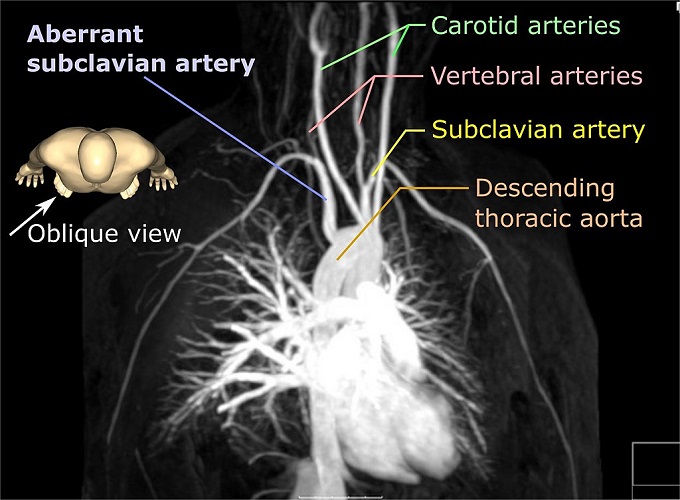Definition
The subclavian arteries (the right subclavian artery and the left subclavian artery) are a pair of major arteries that supply blood to the head, neck, chest, shoulders, and upper extremities. Subclavian means ‘under the clavicle,’, describing where these vessels are found. The subclavian arteries are sometimes associated with peripheral arterial disease and other clinical disorders.

Anatomy of the Subclavian Arteries
Origin of the Subclavian Arteries
The subclavian arteries are found in the thorax, immediately below the clavicles (collar bones). Each artery has a different site of origin. The left subclavian artery arises directly from the aortic arch. In contrast, the right subclavian artery arises from the brachiocephalic artery (also called the brachiocephalic trunk).
Paths of the Left & Right Subclavian Arteries
From their respective sites of origin, each subclavian artery progresses towards the anterior scalene muscle, which is a muscle belonging to the group of scalene muscles found on either side of the neck. Each artery then moves through the gap between the anterior and medial scalene muscles. Here, the arteries enter the axillary region, which is essentially the armpit. When it reaches the lateral border of the first rib, it becomes the axillary artery.
Each artery subclavian artery can be divided into three sections: the first, second, and third parts. The first parts run from the site of origin to the medial border of the anterior scalene muscle. The second part is found behind the anterior scalene muscle. The third and final part (before the subclavian artery becomes the axillary artery) is located between the lateral border of the anterior scalene muscle and the outer part of the first rib.
Before becoming the axillary artery, each subclavian branches off into several important vessels. Some key branches are listed below.
- The vertebral arteries are some of the major arteries in the neck and originate from the subclavian arteries. Along with the internal carotid arteries, these vessels supply the brain and spinal cord with blood. In total, the vertebral arteries contribute about 20% of the brain’s blood supply.
- The thyrocervical trunk arises between the origin of the subclavian arteries and the anterior scalene muscles (the first portion of the vessel). The thyrocervical trunk supplies blood to the thyroid, muscles of the upper back, shoulders, and neck.
- The costocervical trunk is a smaller branch of the subclavian artery that supplies the muscles of the neck with blood.
- The internal thoracic artery (also called the mammary artery) arises near the site of origin of the subclavian artery. This vein supplies blood to the thymus, the heart pericardium, the wall of the chest, and the breasts.
- The dorsal scapular artery supplies muscles of the back and neck, including the levator scapulae, rhomboids, and the trapezius.

Function
The subclavian arteries supply oxygenated blood to the head, neck, and upper extremities.
Clinical Relevance
Trauma
Injury to the subclavian arteries is relatively rare, owing to their protection by the clavicles, surrounding muscle, and connective tissue. The subclavian arteries are damaged in less than 5% of trauma cases. If they are damaged by injury, the trauma is usually caused by a penetrative injury, such as gunshot wounds or knife injuries.
Aberrant Subclavian Artery
Aberrant subclavian artery describes an anatomical variant of the subclavian artery. It is a relatively rare congenital condition, occurring in less than 1% of individuals. However, it frequently co-occurs with other cardiac abnormalities, such as those common in individuals with Down syndrome.
Fortunately, this disorder does not usually cause any symptoms. However, symptoms can appear over time, and in later life, it can cause problems swallowing and chest pains. The ICD-10 code for aberrant subclavian artery is Q278.
Subclavian Artery Aneurysm
Weaknesses in the subclavian artery can cause the vessel to enlarge, which is called an aneurysm. Common causes of an aneurism include trauma, thoracic outlet obstruction (compression of the blood vessels around the upper thorax), and arteriosclerosis. Atherosclerosis describes the buildup of fatty plaque in the arteries. The risk factors for the development of atherosclerosis are hypertension, obesity, diabetes, and smoking.
Subclavian artery aneurysms can cause chest pain, numbness, inability to swallow, and fatigue of the upper extremities. It is most commonly repaired through surgery.

Subclavian Artery Stenosis
Subclavian artery stenosis is a type of peripheral artery disease. This disorder is the result of the narrowing of the artery and is also usually caused by atherosclerosis. There are often no symptoms because the disease progresses slowly over time. As a result, the body adapts to the narrowing and creates new vessels to bypass the blood flow. However, it can cause arm weakness and fatigue, as well as light-headedness and dizziness.
Subclavian Artery Thrombosis
Subclavian artery thrombosis occurs when blood flow in the subclavian artery is obstructed by a blockage. It is normally a result of prior damage to the vessel such as through trauma or atherosclerosis. However, it can also be caused by congenital deformities and some auto-immune diseases.
Quiz
